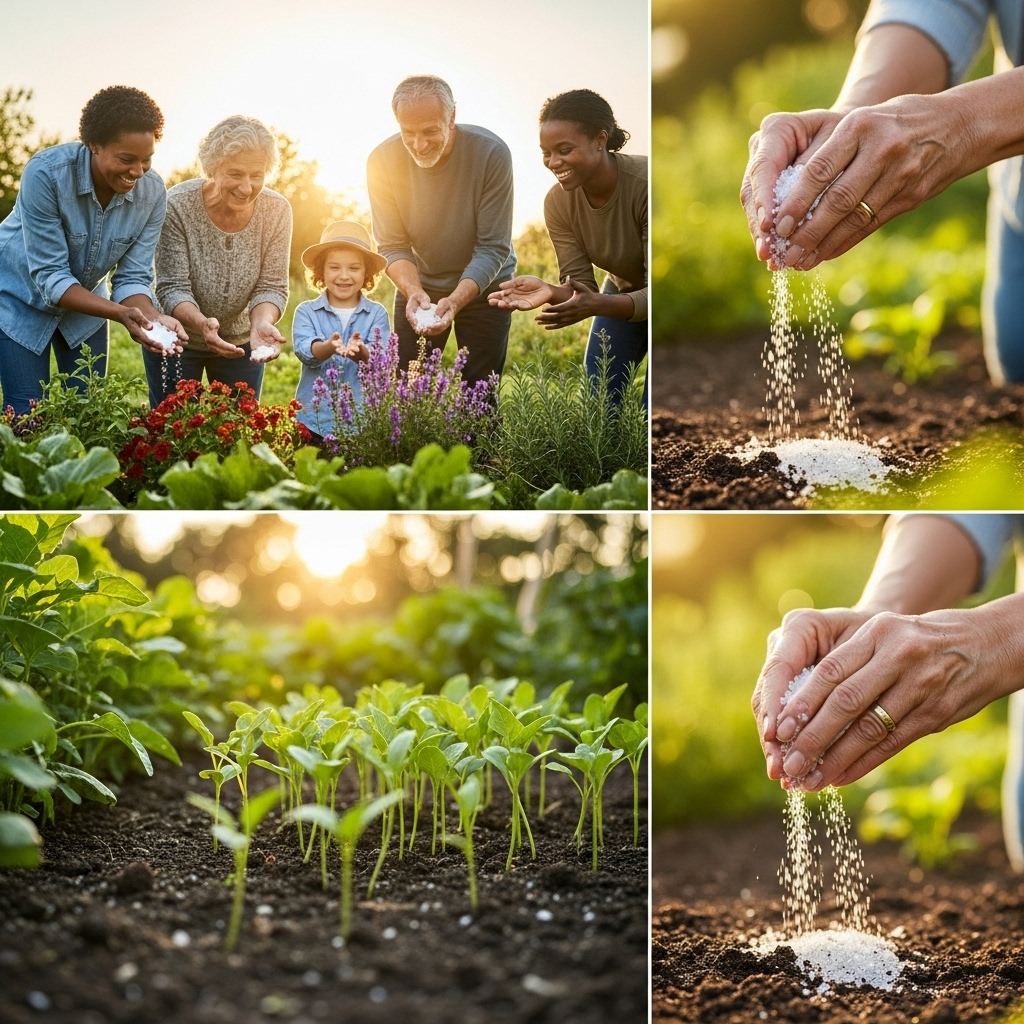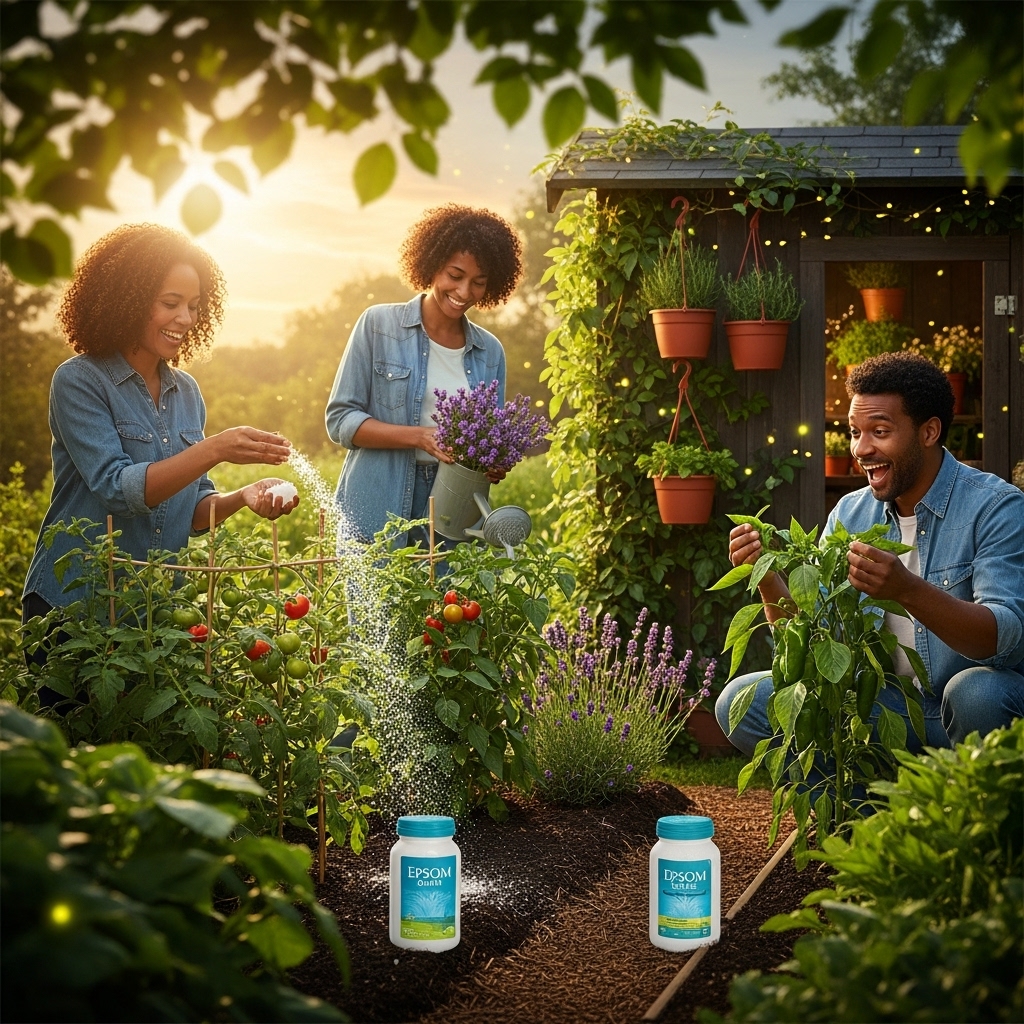As a passionate gardener, I’ve often stumbled upon the claim that Epsom salt can work wonders for plants. But is it really a miracle solution? Let’s delve into the science behind this popular gardening myth and separate fact from fiction.
The Science Behind Epsom Salt

To truly understand whether Epsom salt is a miracle for plants, we need to first explore what Epsom salt actually is. Chemically known as magnesium sulfate, Epsom salt is a naturally occurring mineral compound composed of magnesium, sulfur, and oxygen. It’s often used in baths for its soothing properties, but its role in gardening has garnered significant attention and debate. As I began researching, I was fascinated to discover the various ways magnesium and sulfur contribute to plant health.
Importance of Magnesium for Plants
Magnesium is an essential nutrient for plants, playing a crucial role in photosynthesis. This process allows plants to convert sunlight into energy, forming the foundation of their growth and development. Magnesium is a central component of chlorophyll, the green pigment responsible for absorbing sunlight. Without sufficient magnesium, plants can exhibit symptoms of deficiency, such as yellowing leaves, stunted growth, and poor fruit development. I’ve seen firsthand how a lack of magnesium can lead to disappointing harvests, which is why I was intrigued by Epsom salt’s potential benefits.
The Role of Sulfur in Plant Growth
Sulfur, another key component of Epsom salt, is vital for the synthesis of certain amino acids and proteins, which are essential for plant growth and development. It also plays a role in the formation of chlorophyll and helps plants resist disease. In my own gardening experience, I’ve observed that sulfur can aid in improving soil health and enhancing the flavor of fruits and vegetables. It’s fascinating to think that a compound containing both magnesium and sulfur could have such a positive impact on plant health.
How Epsom Salt Works in the Soil
When I began using Epsom salt in my garden, I wanted to understand how it interacts with the soil and plants. Epsom salt is highly soluble in water, making it easy for plants to absorb the magnesium and sulfur it contains. This solubility allows for quick action; when applied to the soil or foliage, these nutrients can be readily taken up by the plant roots or leaves. I’ve found that diluting Epsom salt in water and applying it as a foliar spray can yield rapid results, especially for plants showing signs of nutrient deficiencies.
Application Techniques
In my quest to maximize the benefits of Epsom salt, I experimented with various application techniques. One effective method is mixing Epsom salt with water and spraying it directly onto the leaves of plants. This foliar application can quickly address magnesium deficiencies, particularly in fast-growing plants like tomatoes, peppers, and roses. I’ve noticed a remarkable difference in the vibrancy of my plants after using this method.
Another way to incorporate Epsom salt is by mixing it into the soil before planting. A common ratio I use is about one tablespoon of Epsom salt per gallon of water for watering established plants or about one tablespoon per square foot when preparing garden beds. This ensures that the nutrients are available to the plants from the start. I’ve found that this practice not only enhances growth but also improves the overall health of the soil.
Potential Benefits and My Experiences
Throughout my gardening journey, I’ve observed several potential benefits of using Epsom salt. One significant advantage is the improved flower and fruit production. For instance, when I grew my tomato plants in soil enriched with Epsom salt, I noticed that they produced larger and sweeter tomatoes compared to previous years. Similar results were evident with my pepper plants, which bore more fruit and displayed a richer flavor.
Additionally, Epsom salt can help prevent blossom end rot, a common issue in tomatoes and peppers caused by calcium deficiency. While Epsom salt doesn’t contain calcium, the magnesium in it can help plants absorb calcium more effectively from the soil, mitigating this issue. This was particularly beneficial to me as I often struggled with this problem in previous seasons.
Addressing Misconceptions
Despite the numerous benefits I’ve experienced with Epsom salt, I have also encountered misconceptions about its use. One of the most common is the belief that Epsom salt is a cure-all for every plant problem. While it is beneficial for addressing magnesium and sulfur deficiencies, it’s essential to remember that plants require a balance of numerous nutrients. Over-application can lead to nutrient imbalances and even hinder growth. I’ve learned the importance of testing soil and understanding my plants’ specific needs before relying solely on Epsom salt.
As I continue to explore the role of Epsom salt in my gardening practices, I remain excited about the potential it holds. The science behind magnesium and sulfur’s role in plant health is compelling, and my experiences have led me to believe that Epsom salt can indeed be a powerful tool in nurturing healthy, vibrant plants.
Other Uses of Epsom Salt in the Garden

As I continued my exploration of Epsom salt, I discovered that its benefits extend far beyond just addressing nutrient deficiencies. There are several other applications that I’ve found to be incredibly useful in my gardening endeavors. One such use is as a natural pest deterrent. I was surprised to learn that mixing Epsom salt with water and spraying it on plants can help keep certain pests at bay. This method has proven particularly effective against slugs and snails, which can wreak havoc on tender seedlings and leafy greens. Since implementing this technique, I’ve noticed a significant reduction in these pesky intruders in my garden.
Moreover, I’ve begun using Epsom salt as a soil amendment. The addition of magnesium and sulfur not only benefits the plants directly but also enhances the overall health of the soil. By mixing Epsom salt into my compost, I can ensure that these vital nutrients are made available to my plants as the compost breaks down. I find this especially helpful in enriching the soil of my raised beds, which tend to deplete nutrients more quickly due to frequent planting and harvesting. The result has been a more robust and productive growing environment.
Enhancing Seed Germination
Seed germination is another area where I’ve noticed positive effects from Epsom salt. I began experimenting by soaking my seeds in a solution of Epsom salt before planting. The magnesium in Epsom salt is known to help seeds absorb water more effectively, which can lead to faster and more uniform germination. I’ve seen this benefit firsthand with my beans and peas, which sprouted noticeably quicker when treated with this technique. It’s a simple step that makes a significant difference, and I now incorporate it into my planting routine.
Improving Soil Structure
Another fascinating aspect I’ve come to appreciate is how Epsom salt can improve soil structure. I’ve learned that magnesium helps in the formation of soil aggregates, which can enhance aeration and drainage. In my heavy clay soil, adding Epsom salt has made a noticeable impact on its texture. The soil has become less compact and more workable, allowing roots to penetrate more easily and access nutrients. This change has greatly benefited my root vegetables, leading to larger and healthier crops.
Using Epsom Salt for Houseplants
Beyond my outdoor garden, I’ve also started to apply Epsom salt in caring for my houseplants. I’ve found that many indoor plants enjoy the benefits of magnesium as well. A diluted solution applied every month or so has helped my houseplants thrive. I particularly notice a difference in my leafy greens, which appear more vibrant and lush. It’s gratifying to see how a simple compound can make such a profound difference in plant health, even indoors.
Environmental Considerations
As I’ve embraced the use of Epsom salt in my gardening practices, I’ve also become more aware of the environmental implications. Epsom salt is relatively benign compared to chemical fertilizers, which can leach into waterways and cause pollution. I appreciate that Epsom salt is a natural mineral and, when used responsibly, can be a more eco-friendly option. However, I’ve learned to always apply it judiciously. Too much of a good thing can lead to an imbalance in the soil, and I remain cautious about my usage to promote sustainable gardening practices.
Personal Observations and Reflections
Reflecting on my journey with Epsom salt, I realize how much I’ve grown as a gardener. Each application and observation has taught me valuable lessons about my plants’ needs and the importance of balanced nutrition. I appreciate the improvements I’ve seen, but I also understand that gardening is a continuous learning process. While Epsom salt has certainly played a role in my success, I recognize the importance of considering a full spectrum of nutrients and practices.
My ongoing experiences with Epsom salt have inspired me to keep experimenting and learning. The more I engage with my garden, the more I discover about the intricate relationships between soil, nutrients, and plant health. I encourage fellow gardeners to explore Epsom salt with an open mind and to observe its effects on their unique gardening situations. It’s a journey that can lead to delightful surprises and a deeper understanding of the natural world.
Final Thoughts
As I wrap up my insights on Epsom salt, I remain optimistic about its potential in promoting plant health and enhancing my gardening experience. The combination of magnesium and sulfur, along with its various applications, has proven to be a valuable asset in my garden. I look forward to continuing this journey of exploration and discovery, always seeking new ways to nurture my plants and enjoy the fruits of my labor.
